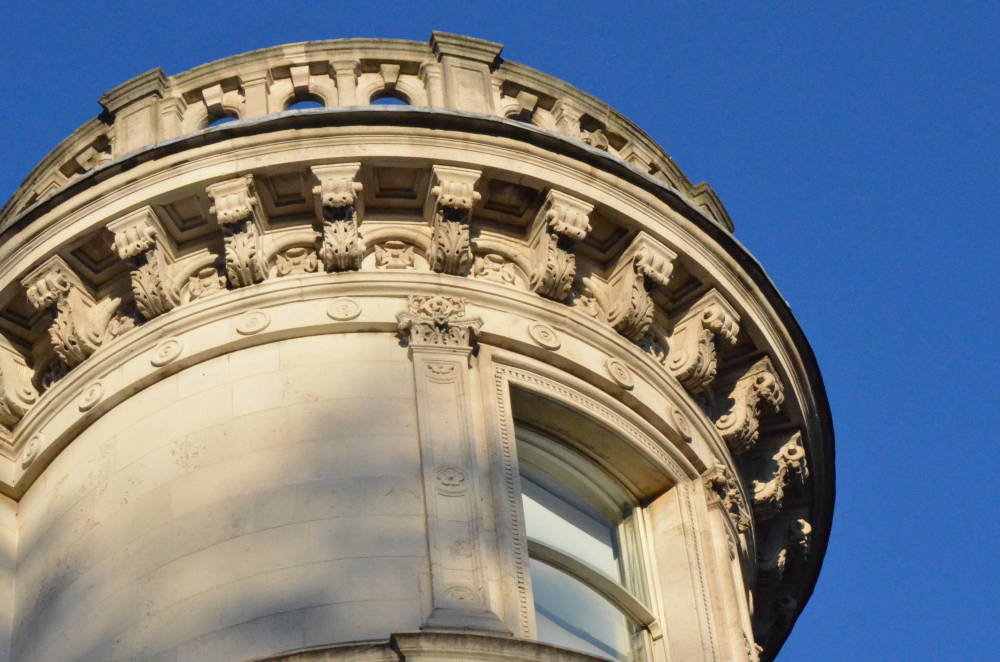
East elevation of Nos. 1 and 2 Temple Gardens. Listed Building. E M Barry. 1875-80. Portland stone building "in modified, French chateau style" (listing text). The set of chambers consists of two blocks, on the east and west of Middle Temple Lane, with Inner Temple Gardens on the east side and Middle Temple Gardens on the west. The two blocks are joined over the entrance archway leading from the Embankment into the lane. The adjoining brick buildings seen here on the right are the back of the Harcourt Buildings, rebuilt on Robert Smirke's foundations after World War II. [Click on the photographs to enlarge them.]


Left: South elevation with corner tower. Right: Detail of corner tower.

The archway between Temple Gardens 1-2 (in Inner Temple), and Temple Gardens 3 (in Middle Temple). The listing text describes Temple Gardens buildings as a whole thus: "Battered basement, and 4 main storeys plus 2 in steep slated roof with cresting. Rounded corner towers; tall bay windows; balconies; rich figure sculpture and carving. Elaborated centre-piece and stone dormers etc." The sculptural decoration was by Mabey & Co (see Ward-Jackson 400) apart from the very appropriate over-life-size figures by William Calder Marshall of Learning and Justice in the canopied niches.


Left: Medallions with women's heads in high relief on the side and front of the pilasters above the archway. Right: Two heads on a frieze between windows. The latter must be (on the left) Diana with a crescent moon, and (on the right) her twin brother Apollo, the sun god.


Left: The other side of the archway. This is much plainer than the Gardens side, but has shields showing Pegasus on the left, emblematic of the Inner Temple, and a lamb and flag on the right, emblematic of Middle Temple. The Temple Gardens buildings are the only ones shared between both Inns of Court. Barry had been appointed by the Inner Temple, and J. P. Aubyn, who had also been involved in the 1860s restoration of the Temple Church, was the surveyor/architect for the Middle Temple, with whom Barry consulted. Right: Entrance to 1 Temple Gardens. The initials WHC above the door stand for William Henry Cooke, treasurer at the time of construction. This is the more intimate side of the archway.
Early opinion about Temple Garden buildings and the Embankment entrance seems to have been unfavourable. "A picturesque gateway here, even a plain but well-proportioned one, like Wren's at the top, would have been a conspicuous ornament to the neighbourhood," grumbles one early commentator (Loftie 135). What was actually erected in this spot was "vulgar in its ornateness, and entirely out of place ... a vulgar monstrosity," inveighs another (Bellot 294-95). But today Barry's work is considered "exuberant and eclectic .. .an imposing introduction to the Lane" ("Conservation Area," 3).
All photographs except the last two by George P. Landow, commentary and last two photographs by Jacqueline Banerjee. [You may use these images without prior permission for any scholarly or educational purpose as long as you (1) credit the photographer and (2) link your document to this URL in a web document or cite the Victorian Web in a print one.
Related Material
References
Bellot, Hugh Hale Leigh. The Inner and Middle Temple: Legal, Literary, and Historical Associations. London: Methuen, 1902.
"Conservation Area Character Summary: Temples.". City of London, 2007. Web. 18 December 2011.
Loftie, W. J. The Inns of Court and Chancery. London: Seeley & Co., 1895. Internet Archive. Web. 18 Dec. 2011.
"Temple Gardens I-4, Inner and Middle Temples." British Listed Buildings. Web. 18 December 2011.
Ward-Jackson, Philip. Public Sculpture of the City of London. Liverpool: Liverpool University Press, 2003.
Last modified 29 September 2012